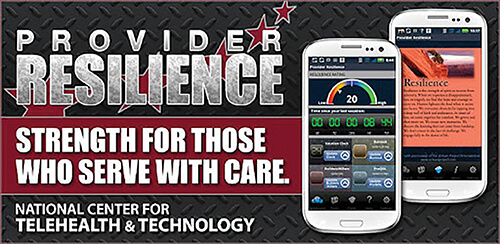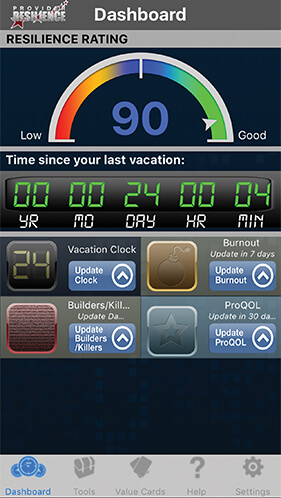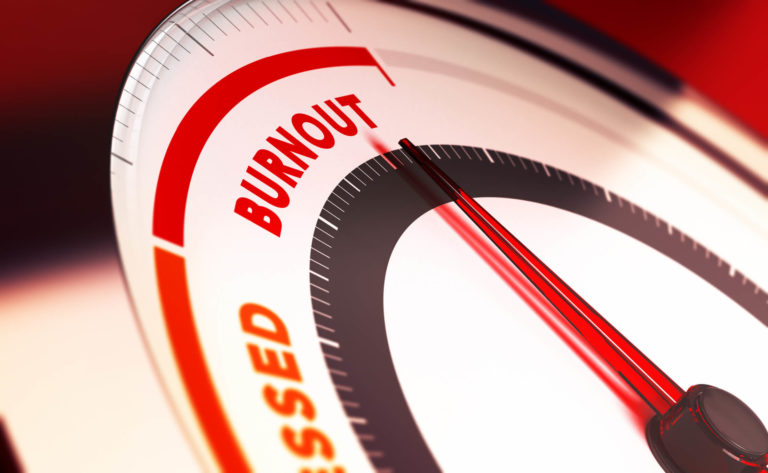AS THE PANDEMIC CONTINUES TO OVERWHELM HOSPITALS AND STAFF, MOBILE STRATEGIES TO ADDRESS MENTAL HEALTH STRAIN AMONG HEALTH CARE WORKERS ARE BECOMING MORE READILY AVAILABLE
Health care workers were already stressed before the pandemic. Now, deep into the second year of COVID-19, many find their mental health sliding even further. In the USA, some have had to care for desperately ill but recalcitrant patients who had access to a vaccine but refused to take it. Others, in both the USA and around the world, are working in hospitals, especially rural ones, which are perilously short-staffed [1].
A March 2021 survey by the American Association of International Healthcare Recruitment found that nearly 80% of registered nurses said the pandemic strained staffing in their unit was at “unsafe levels” [2]. During the height of the summer 2021 surge, many hospitals sought to hire nurses from other states, while others turned to their state’s National Guard units. The lack of staff as well as beds also led to health care workers making wrenching decisions about who gets care and who doesn’t.
In a 2021 Medscape survey of more than 12,000 physicians, two-thirds of doctors complained that excessive bureaucratic demands caused them to feel burned out while 37 percent blamed burnout on long hours, and only 8 percent named treating COVID-19 patients as a source of burnout. The result is health care workers who are depressed, anxious, fatigued, unable to sleep, prone to making errors, and sometimes even suicidal. According to a national survey by the Kaiser Family Foundation and The Washington Post, more than 60% of frontline health care workers reported that the pandemic has negatively impacted their mental health [3]. About 18% said they needed mental health services or medications but didn’t get them. The reasons they gave for not seeking help were being too busy, inability to get time off from work, embarrassment, and cost.
Clearly, there’s a problem, and a reason to worry: Several cross-sectional studies link burnout—defined as long-term, unresolved, job-related stress leading to exhaustion, cynicism, detachment from job responsibilities, and lacking a sense of personal accomplishment—to suboptimal patient care, along with a doubled risk of medical error and a 17% increase in being named in a medical malpractice suit [4]. Burnout has also been shown to contribute to a higher risk of motor vehicle accidents (even after adjusting for fatigue) among physicians. Other consequences of burnout include absenteeism, low organizational commitment, increased turnover of skilled staff, and greater patient dissatisfaction.
Recognizing the danger of stressed health care workers, researchers have been working to find ways to ease the problem through mobile applications centered around meditation, mindfulness, relaxation, and insomnia. While mindfulness apps have proliferated in the last decade, including Headspace, Calm, Breethe, Sanvello, Simple Habit, Ten Percent Happier, and Relax, newer platforms geared specifically toward health care providers are now popping up.
In 2020, the University of North Carolina introduced Heroes Health, an app for first responders and health care providers delivering weekly 5- to 10-minute mental health self-assessments, symptom summary reports, and trends over time [6]. It also provides links to support and mental health resources, with an emphasis on services that are free and immediate. In 2017, the Mayo Clinic licensed its Well-Being Index, a platform tracking physician distress, to MedEd Web Solutions to create an online tool available not only to Mayo providers but other institutions [7].
One of the first apps to be developed with health care providers in mind was the Provider Resilience app, launched by the Department of Defense in 2013, which is available for free to any frontline health care professional who needs it (Figure 1). Designed at the National Center for Telehealth and Technology under the Defense Centers for Psychological Health and Traumatic Brain Injury, the app was originally focused on helping military doctors deal with the kinds of extreme stresses they often face. In 2020, a completely redesigned app has proven a useful resource for civilian health care workers. It offers a burnout assessment and scale based on the user’s responses to questions, tracks vacation time, provides exercises and guided meditations, as well as an area to write journal entries (Figure 2). Each of these activities has been shown in studies to help with mental health.

Kelly Blasko, an electrical engineer and psychologist who serves as the mHealth Clinical Integration Lead at the Defense Health Agency (Figure 3), notes that the Provider Resilience app was originally a response to a need identified by behavioral health providers, particularly those working patients suffering from post-traumatic stress disorder (PTSD). “There were a lot of workload issues but also the types of conditions providers were treating often had some kind of trauma associated with them,” Blasko says. “Providers doing that kind of work have to be careful to self-care [in order] to not get burned out or lose compassion for the people they’re treating. So, there was this identified need, and there was nothing out there that focused specifically on providers.”


Since 2013, there have been several updates and more than 77,000 downloads. Almost 18,000 of those downloads occurred in the period between April 2020 and September 2021. “The first kind of provider it focused on was in behavioral health, but now it’s been expanded to any type of health care provider, even a daycare provider or someone who is dealing with the public and providing some type of service,” Blasko adds.
In addition, the Center has developed other apps geared toward mental health: Breathe2Relax, T2Moodtracker, and Virtual Hopebox. Breathe2Relax encourages users to learn the stress management tool of diaphragmatic breathing, while T2Moodtracker, geared toward individuals exposed to trauma, is designed to help users track their mood over time. The Virtual Hopebox app is aimed at users who may be struggling with depression and includes sections designed for distraction, inspiration, and relaxation.
The Defense Health Agency has a usability lab where service members, providers, family members, and retirees have been brought in to conduct testing of these apps, including new features. “After it was developed, there was research by Wood et al. [7], looking at the app in a small pilot with 30 providers within Veterans Affairs,” Blasko states. “That article also looked at usability and it was a pretty good positive outcome study. There have not been randomized controlled trials.”
Even with positive feedback, there has been some discrepancy among studies as to whether the use of an app actually improves burnout or compassion fatigue for health care workers [8]. “With COVID-19 and a heightened awareness of provider resilience because of workload, we realized it’s not one app or even one self-care tool that can cover all needs,” Blasko says. “The other thing we anticipated is that it’s not a sprint, it’s a marathon. And we are all experiencing this as a marathon at this point. We want to be preventative, so that as we go along these tools are available.”
One important area to consider when developing these types of applications is cybersecurity. “Being a part of the Department of Defense, we wanted to make sure that security measures are in place for any data that’s on the phone as well as data in transit,” Blasko says. “The data is encrypted on your app, so you are the only one that can see the data unless you choose to share it. And that’s important because there’s a lot of stigma associated with mental health care, even among providers. It could impact their career.”
As to the bottom line in addressing the burnout issue, apps such as Provider Resilience are only one avenue in a larger plan. “Really the first step for providers is to recognize signs of burnout, like anxiety, depression, and isolation. The second part of that is that although many providers have self-care strategies in place, what happens when you’re under stress? We want to be providing them a toolkit,” Blasko adds.
“I think the main message is that this is a tool to encourage providers to do self-care. And even if providers do have self-care strategies, this app is either to remind them, or to augment what they currently are doing.”
Learn more about Provider Resilience
- Dr. Kelly Blasko talks about mental health during pandemic: https://www.youtube.com/watch?v=wjNXPwyNBng
- Dr. Kelly Blasko talks to Capt. Jennifer Bodart: https://www.dvidshub.net/video/791760/provider-resilience-with-dr-kelly-blasko-and-captain-jennifer-bodart
- Dr. Kelly Blasko talks to Senior Airman Clayton Johnson: https://www.youtube.com/watch?v=LfbRDWu_ZRg
References
- A. Wright, “Rural hospitals can’t find the nurses they need to fight COVID.” [Online]. Available: https://www.pewtrusts.org/en/research-and-analysis/blogs/stateline/2021/09/01/rural-hospitals-cant-find-the-nurses-they-need-to-fight-covid
- “Nationwide nurse survey points to mass exodus from bedside, huge increase in nurse-to-patient ratios,” Business Wire. [Online]. Available: https://www.businesswire.com/news/home/20210405005266/en/Nationwide-Nurse-Survey-Points-to-Mass-Exodus-From-Bedside-Huge-Increase-in-Nurse-to-Patient-Ratios
- A. Kirzinger, A. Kearney, L. Hamel, and M. Brodie, KFF/The Washington Post Frontline Health Care Workers Survey. [Online]. Available: https://www.kff.org
- L. Sovød et al., “Prioritizing the mental health and well-being of healthcare workers: An urgent global public health priority,” May 2021. [Online]. Available: https://www.frontiersin.org/articles/10.3389/fpubh.2021.679397/full#B17
- UNC Health, “‘Heroes Health’ mental wellness app launched by School of Medicine and UNC Health,” Jul. 2020. [Online]. Available: https://www.unc.edu/posts/2020/07/14/heroes-health-mental-wellness-app-launched-by-school-of-medicine-and-unc-health/
- Mayo Clinic Well-Being Index – Survey Your Healthcare Professionals. [Online]. Available: https://www.mywellbeingindex.org
- A. Wood et al., “Reduction of burnout in mental health care providers using the Provider Resilience mobile application,” Community Mental Health J., vol. 53, no. 4, pp. 452–459, 2017. [Online]. Available: https://psycnet.apa.org/record/2017-01469-001
- P. Jakel, J. Kenney, N. Ludan, and P. Miller, “Effects of the use of the provider resilience mobile application in reducing compassion fatigue in oncology nursing,” Clin. J. Oncol. Nursing, vol. 20, no. 6, pp. 611–616, 2016, doi: 10.1188/16.CJON.611-616.



